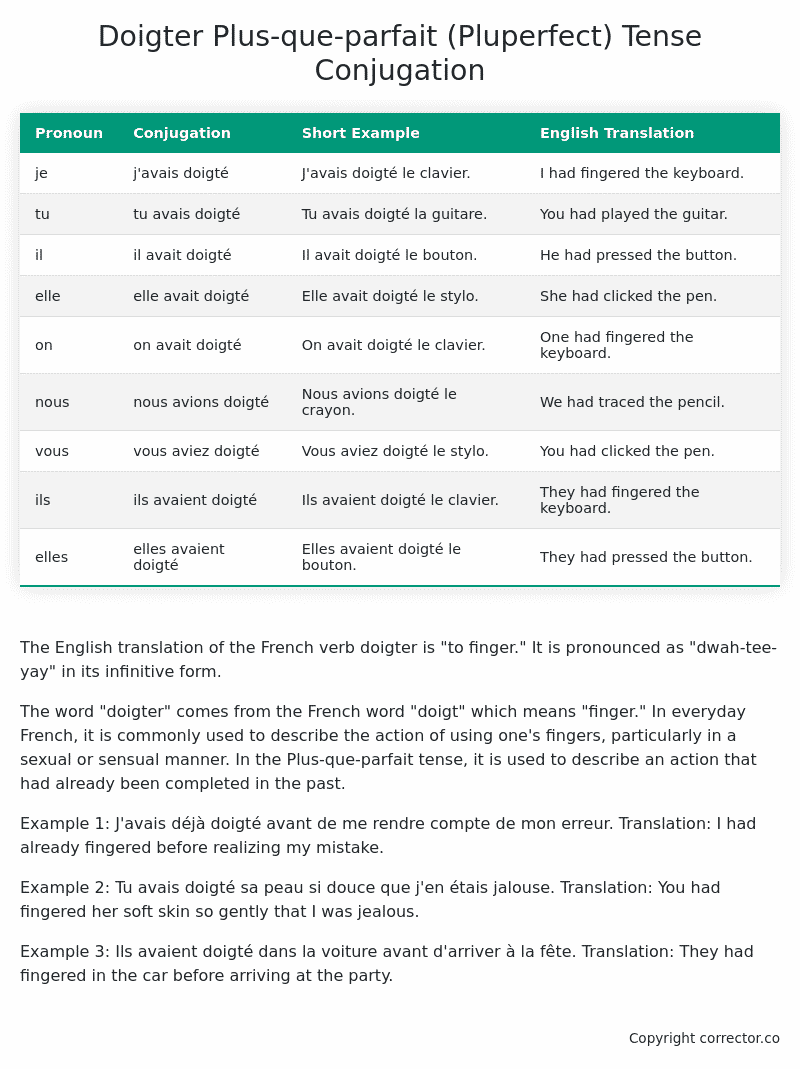Plus-que-parfait (Pluperfect) Tense Conjugation of the French Verb doigter
Introduction to the verb doigter
The English translation of the French verb doigter is “to finger.” It is pronounced as “dwah-tee-yay” in its infinitive form.
The word “doigter” comes from the French word “doigt” which means “finger.” In everyday French, it is commonly used to describe the action of using one’s fingers, particularly in a sexual or sensual manner. In the Plus-que-parfait tense, it is used to describe an action that had already been completed in the past.
Example 1: J’avais déjà doigté avant de me rendre compte de mon erreur.
Translation: I had already fingered before realizing my mistake.
Example 2: Tu avais doigté sa peau si douce que j’en étais jalouse.
Translation: You had fingered her soft skin so gently that I was jealous.
Example 3: Ils avaient doigté dans la voiture avant d’arriver à la fête.
Translation: They had fingered in the car before arriving at the party.
Table of the Plus-que-parfait (Pluperfect) Tense Conjugation of doigter
| Pronoun | Conjugation | Short Example | English Translation |
|---|---|---|---|
| je | j’avais doigté | J’avais doigté le clavier. | I had fingered the keyboard. |
| tu | tu avais doigté | Tu avais doigté la guitare. | You had played the guitar. |
| il | il avait doigté | Il avait doigté le bouton. | He had pressed the button. |
| elle | elle avait doigté | Elle avait doigté le stylo. | She had clicked the pen. |
| on | on avait doigté | On avait doigté le clavier. | One had fingered the keyboard. |
| nous | nous avions doigté | Nous avions doigté le crayon. | We had traced the pencil. |
| vous | vous aviez doigté | Vous aviez doigté le stylo. | You had clicked the pen. |
| ils | ils avaient doigté | Ils avaient doigté le clavier. | They had fingered the keyboard. |
| elles | elles avaient doigté | Elles avaient doigté le bouton. | They had pressed the button. |
Other Conjugations for Doigter.
Le Present (Present Tense) Conjugation of the French Verb doigter
Imparfait (Imperfect) Tense Conjugation of the French Verb doigter
Passé Simple (Simple Past) Tense Conjugation of the French Verb doigter
Passé Composé (Present Perfect) Tense Conjugation of the French Verb doigter
Futur Simple (Simple Future) Tense Conjugation of the French Verb doigter
Futur Proche (Near Future) Tense Conjugation of the French Verb doigter
Plus-que-parfait (Pluperfect) Tense Conjugation of the French Verb doigter (this article)
Passé Antérieur (Past Anterior) Tense Conjugation of the French Verb doigter
Futur Antérieur (Future Anterior) Tense Conjugation of the French Verb doigter
Subjonctif Présent (Subjunctive Present) Tense Conjugation of the French Verb doigter
Subjonctif Passé (Subjunctive Past) Tense Conjugation of the French Verb doigter
Subjonctif Imparfait (Subjunctive Imperfect) Tense Conjugation of the French Verb doigter
Subjonctif Plus-que-parfait (Subjunctive Pluperfect) Tense Conjugation of the French Verb doigter
Conditionnel Présent (Conditional Present) Tense Conjugation of the French Verb doigter
Conditionnel Passé (Conditional Past) Tense Conjugation of the French Verb doigter
L’impératif Présent (Imperative Present) Tense Conjugation of the French Verb doigter
L’infinitif Présent (Infinitive Present) Tense Conjugation of the French Verb doigter
Struggling with French verbs or the language in general? Why not use our free French Grammar Checker – no registration required!
Get a FREE Download Study Sheet of this Conjugation 🔥
Simply right click the image below, click “save image” and get your free reference for the doigter Plus-que-parfait tense conjugation!

Doigter – About the French Plus-que-parfait (Pluperfect) Tense
Tense Formation
Common everyday usage patterns
Sequencing of past events
Background information
Hypothetical or reported speech
Interactions with other tenses
Summary
I hope you enjoyed this article on the verb doigter. Still in a learning mood? Check out another TOTALLY random French verb conjugation!


